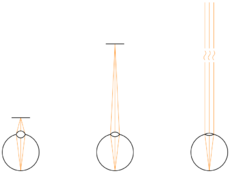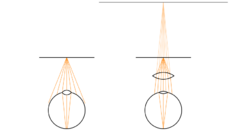Virtual Reality Headset Lenses
Introduction[edit]
The lenses in a virtual reality head-mounted display (HMD) make possible to focus on the images produced by the displays that are very close to a user’s eyes. The lenses are placed between the screens and the viewer’s eyes, giving the illusion that the images are out to a distance where they can be viewed comfortably. This is achieved through the lenses in the VR HMD helping to reduce the least distance of distinct vision. It should be noted that if a user normally needs glasses or contact lenses to clearly see objects far away, he will need to wear the glasses or lenses while using the VR equipment. [1][2]
The lenses of the eyes[edit]
The need for lenses in the virtual reality HMDs is related to how the human eyes function. The eyes have built-in lenses that are placed behind the pupils. On the back of the eyes, there are light-sensitive receptors (rods and cones) that send the received light input signals to the brain in order to translate them into images. [3]
It is very hard or even impossible to focus on things that are very close to the eyes. For example, if a person puts a piece of paper with text on it, one inch in front of one of the eyes, it will prove difficult to read it unless that person is extremely near-sighted. [1]
The lenses in the eyes alter the incoming light in order to focus it on the receptors. The lenses bend according to the distance between the object being focused on and the eyes, converging the incoming light rays on the light-sensitive cells on the retina. When an object is closer to the eye’s lens, the rays coming from that object diverge at a large angle and, consequently, the lens has to adjust in order to focus the rays on the retina (Figure 1). Rays of light coming from an object at medium range will diverge less, and rays from an object infinitely far away are parallel and do not diverge. This means that as the distance between the eye and the object increases, the eye’s lens does not need to bend as much to maintain focus. This process of changing the shape of the lenses is called accommodation, and it is common not only in human but also other mammals, birds, and reptiles. [1][3][4]
A ring of muscle around the lens - the ciliary muscle - is responsible for making the lens thicker and rounder when viewing close objects; the muscles relax, flattening the lenses when the object is at a distance. There is a limit to how much the muscles can compress the lens. This means that there is a minimum distance on which the eye can focus. Generally, it is around 4 inches for children and young adults with normal vision. This value increases with age. [1]
Regarding virtual reality, this biological limitation affects the engineering of the VR HMDs. Since it is not possible to focus the images produce by a screen inches away from the face, lenses placed between the user’s eyes and the display are necessary in order to provide focus. [1]
Lenses in HMDs[edit]
Lenses are needed in VR HMDs in order to bend the light, making it easier for our eyes to accommodate the incoming rays and correctly see the images generated on a display that is 1.2 to 3 inches from the user’s eyes. With the lenses, the images are perceived farther away than they really are. The intermediate lens bends light rays, reducing the divergence angle of light coming from the screen to a point where the eye can focus it (Figure 2). [3][4]
The created illusion of an image that is farther away than in reality is called a virtual image. If the rays of light between the intermediate lens and the eyes are projected backward, they will intersect in a single point behind the VR screen (Figure 2). This is the reason why users can focus on the images from the VR displays that are so close to their eyes. They are not trying to focus on images generated very close to their faces but on virtual images that seems to be at a larger distance. The distance of the virtual images depends on the model of the HMD. In the Oculus Rift DK1, the virtual screens were infinitely far away while in the Oculus Rift DK2, they were about 4.5 feet away. [1]
The HMDs can also use Fresnel lenses. Indeed, the HTC Vive uses this type of lenses, and the Oculus Rift CV1 has hybrid Fresnel lenses. These lenses are used to make the headset’s lenses thinner and lighter while maintaining the same function as regular lenses. Fresnel lenses have the same curvature than normal lenses but they are segmented (Figure 3). [3][4] However, there are some compromises when using Fresnel lenses: firstly, creating lenses with many segments will result in a sharper image but some light will be lost that gets scattered at the lenses’ peaks (Figure 3). Secondly, Fresnel lenses with fewer segments will result in less scattered light but the image will not be as sharp (Figure 4). [4]
Valve’s new lenses[edit]
On October 2017, Valve revealed new lenses for headsets compatible with SteamVR. According to Valve, these lenses improve VR experiences on OLED and LCD HMDs. On the press release, the company wrote that “the lenses, which are designed to support the next generation of room-scale virtual reality, optimize the user’s perceived tracking experience and image sharpness while reducing stray light. Valve is including the custom lens calibration and correction software within the SteamVR technology suite.” [5]
Valve has clarified that the lenses will only be available for developers of SteamVR-compatible HMDs and not to the general public. [5]
References[edit]
- ↑ 1.0 1.1 1.2 1.3 1.4 1.5 Doc-Ok.org (2016). Head-mounted displays and lenses. Retrieved from http://doc-ok.org/?p=1360
- ↑ Santillian, R. DIY virtual reality tutorial: How to Make a VR Headset. Retrieved from https://diyhacking.com/diy-virtual-reality-headset/
- ↑ 3.0 3.1 3.2 3.3 VR Lens Lab (2016). How lenses for virtual reality headsets work. Retrieved from https://vr-lens-lab.com/lenses-for-virtual-reality-headsets
- ↑ 4.0 4.1 4.2 4.3 VR Cover (2016). How lenses for virtual reality headsets work [Video]. Retrieved from https://www.youtube.com/watch?v=NCBEYaC876A
- ↑ 5.0 5.1 Beck, K. (2017). Some VR headsets could be getting new, improved lenses. Retrieved from http://mashable.com/2017/10/10/valve-vr-lenses/#YbTCqoFltqqL



